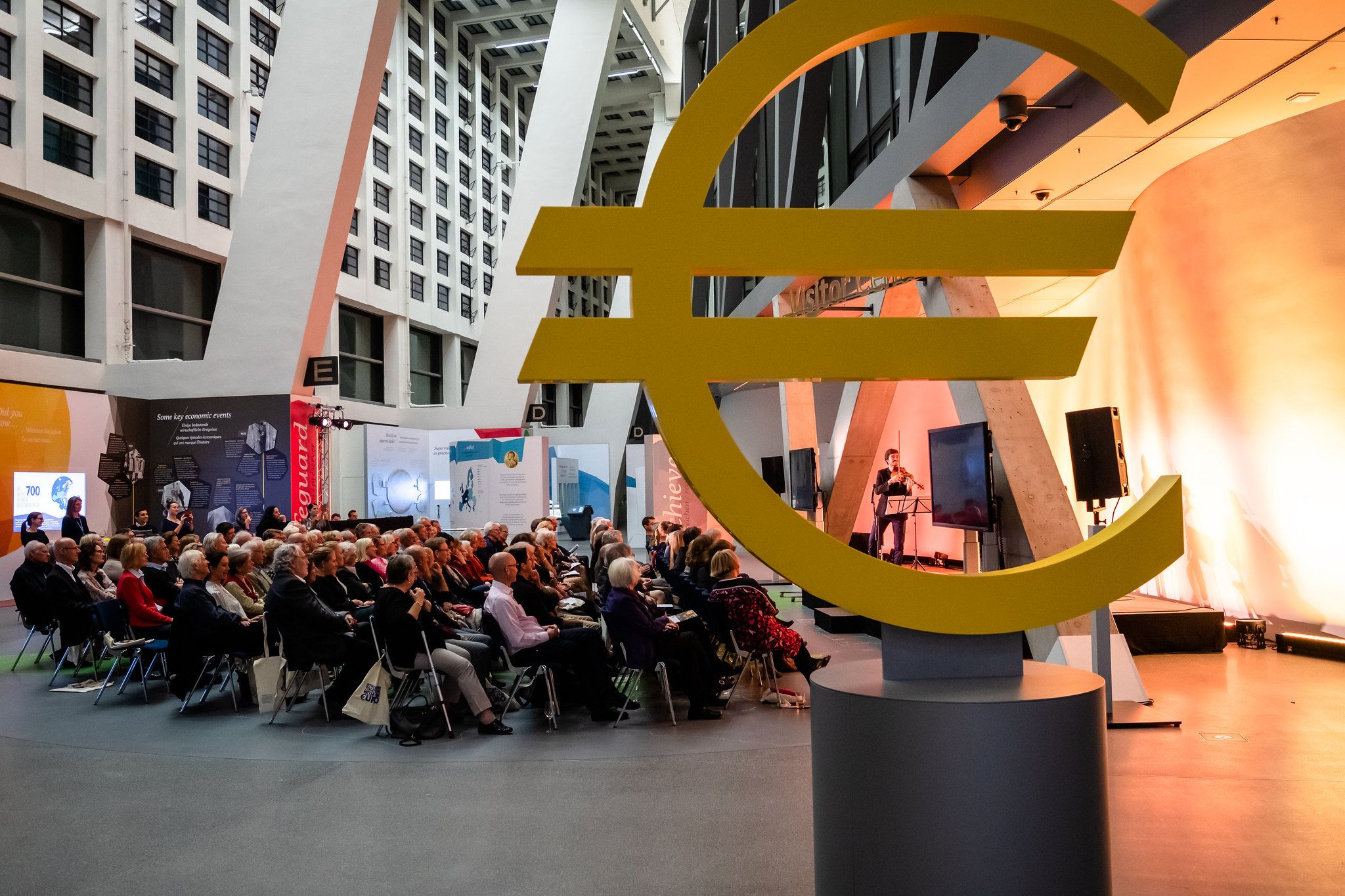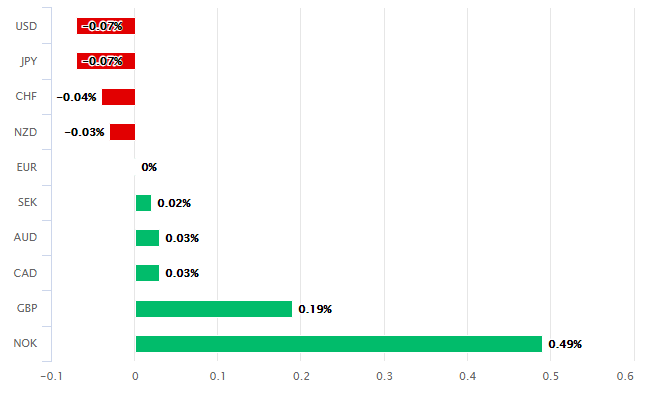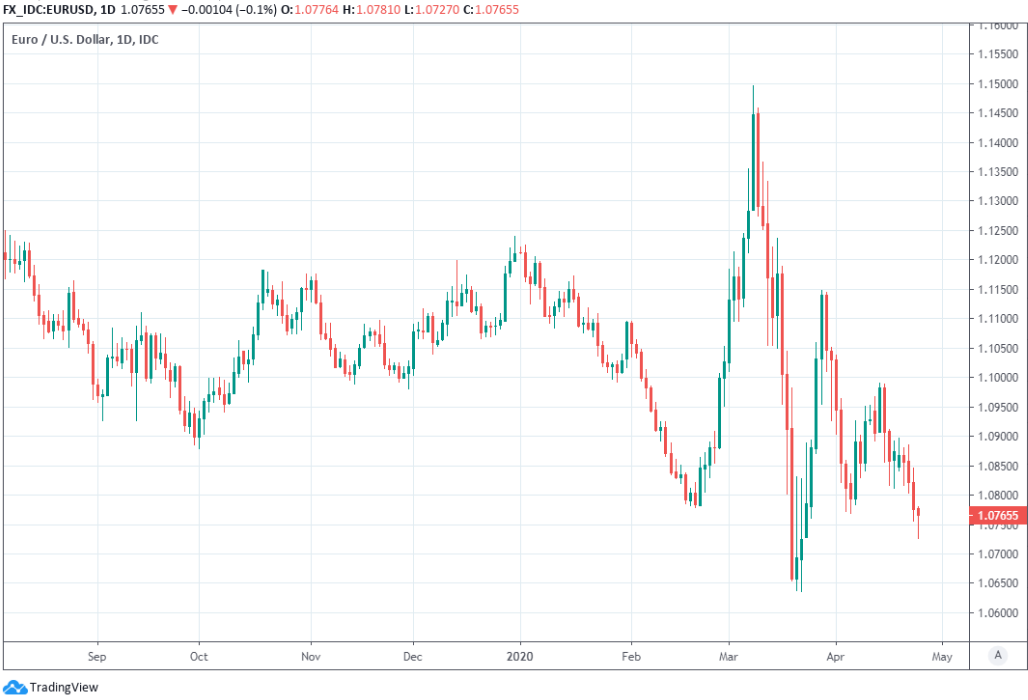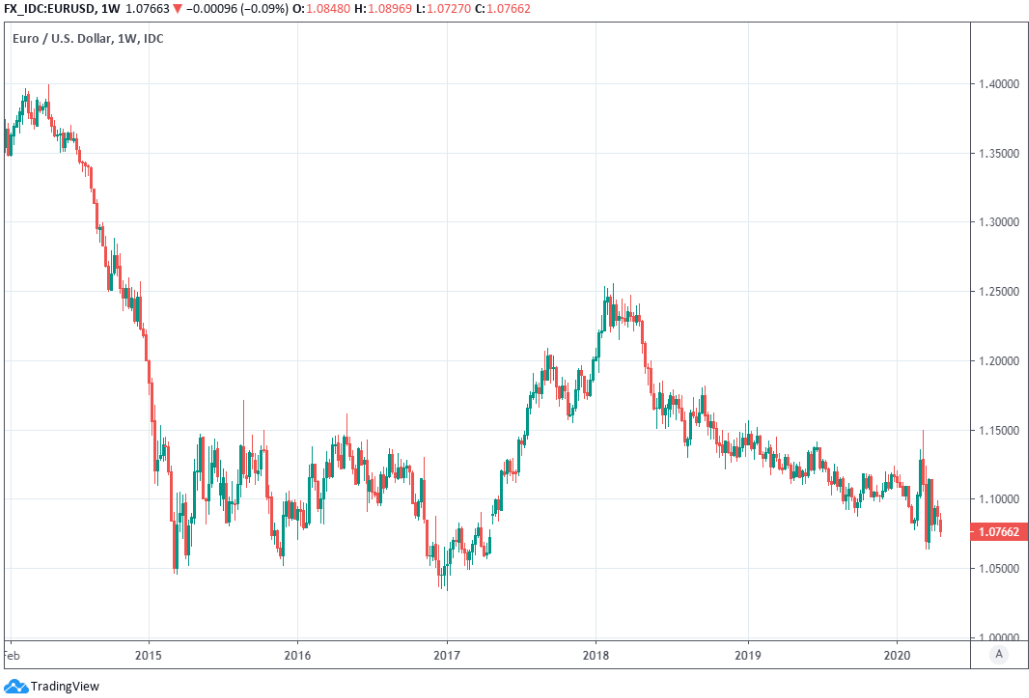Euro-to-Dollar Rate Left Clutching for Support after EU Leaders Kick Corona Bond Can
- Written by: James Skinner
-
- EUR/USD on back foot after EU leaders kick corona bond can.
- EU approves €540bn aid but dodges decision on coron bonds.
- But its May before decisions made, June for aid funds to go live.
- Dithering ensures weak recovery and scope for more acrimony.

Image © European Central Bank
- EUR/USD spot at time of writing: 1.0761
- Bank transfer rates (indicative): 1.0410-1.0486
- FX specialist rates (indicative): 1.0626-1.0691 >> More information
The Euro ceded ground to a strengthening Dollar on Friday after being weighed down in the overnight session by investor disappointment with the EU response to the coronavirus crisis, which has dented sentiment toward the single currency and left it it clutching for support.
EU leaders kicked the can that is their collective response to the coronavirus crisis down the road and into May on Thursday, risking further acrimony between member states and crimping appetite for the single currency. This is after agreeing in principle to endorse an eagerly-awaited recovery fund but deferring decisions over the size and nature of its financing until May 06, with decisions now taken in conjunction with those on the next multiannual budget.
The €540bn aid package put together by the Eurogroup of finance ministers was endorsed, although neither the markets nor any of the Eurozone's more needy members had much interest in it to begin with. It provides collateral to support European Investment Bank loan guarantees as well as €100bn for a form of unemployment insurance and up to €240bn in European Stability Mechanism loans, but some members wanted something else.
"EU leaders stuck to the long-held strategy of kicking the can," says Petr Krpata, chief EMEA strategist for currencies and bonds at ING. "While this has been seen as a negative for EUR and the currency is down, along with other G10 FX, against USD today, the EU’s piece meal approach and the ECB’s presence in the bond market are likely to be enough to prevent a material risk premium build-up into EUR for now. EUR/USD to stay above the 1.07 support today."
Above: Euro performance relative to major rivals on Friday. Source: Pound Sterling Live.
The Euro had rallied as the leaders' meeting got underway on Thursday, enabling it to briefly reclaim the 1.08 handle lost in earlier trading before it became apparent that political leaders would dodge a decision on whether to support the use of 'corona bonds' or another form of mutualised financing to fund either loans or grants to the member states hardest hit by the coronavirus crisis, which are also the bloc's most indebted and financially fragile countries. The budget deficit for Italy, the bloc's second most indebted member with a debt-to-gdp ratio or more than 130%, is expected to rise above 10% this year.
Southern members including Italy and Spain were lobbying intensely for EU leaders to back the idea of a mutually financed recovery fund, with Italy having been emboldened and egged on by a rising tide of Euroscepticism in the Mediterranean country. However, the deferral of decisions on how to finance the fund and fact that they will be taken alongside those relating to the next seven-year EU budget means not only a delay to the European coronavirus response but also risks stoking more political acrimony down the line. The €540bn rescue package will not become operational until June and the recovery fund, if it materialises, is not expected to operate before January 2021 despite that many economists expect the actual recovery to begin in June or just after.
"Nothing at all has come from the meeting it appears apart from a commitment for the European Commission to seek a compromise plan for the next meeting on 6th May. The summit did not agree on any crucial aspects of this fund – it’s size, how it would be financed or whether distribution would be through loans or grants," says Derek Halpenny, head of research, global markets EMEA and international securities at MUFG.
Above: Euro-to-Dollar rate shown at daily intervals.
Prime Minister Guiseppe Conte said after the meeting there had been "Great progress, unthinkable until a few weeks ago, at the outcome of the European Council just finished." Luigi Di Maio, leader of the Five Star Movement that is the largest party to Italy's governing coalition welcomed the outcome but said; "Now we need to work on the timing, so that the funds are available immediately, to help Italian companies, workers and families."
However, and most notably, the leader of the opposition and former Deputy Prime Minister Matteo Salvini desribed the rescue package as "a dramatic mortgage on the future of Italy and our children" before saying; "Everything else, like the Recovery fund, will only be discussed later, but there is a perennial dependence on Berlin and Brussels."
"Very limited progress on substance but a better effort to send a signal of solidarity rather than of discord," says Holger Schmieding, chief economist at Berenberg. " At least right after the meeting, they managed to not emphasise their disagreements too much. Of course, Macron’s take (“Europe has no future if we cannot find a response”) differs in tone from Angela Merkel’s (“didn’t agree on every point but agreed to work together”). Crucially, Italian prime minister Conte, who had passionately pushed for mutualisation of debt in the form of corona bonds, tweeted “great progress, unthinkable a few weeks ago.”
Above: Euro-to-Dollar rate shown at weekly intervals.
In the short-term the lack of a sizeable European provision simply ensures a sluggish recovery from the current crisis relative to those seen elsewhere, which risks handing the Dollar Index a free lunch by weighing on the Euro-to-Dollar rate. The initial €540bn fiscal response is worth a low single digit share of EU GDP and pales into insignificance when compared with the actions of some individiual members states and many independent nation states.
It remains to be seen whether Eurozone leaders will reach an agreement on the post-crisis recovery fund in May, although the possible long-term consequences will build the longer that member states remain at odds with one another. Anti-Euro sentiment has already been lifted in Italy and the political narratives that can be spun and perpetuated from the fractious response of the members so far, could dog the Euro for long after the coronavirus disappears.
The Euro entered 2020 with markets looking for a steady rise throughout and to 1.15 by year-end, but increasing numbers now tip 1.05 at the 2020 curtain close while some even see it falling as low as 1.02 by the end of June.
"EUR/USD is expected to recover from yesterday’s low at 1.0756 and targets the 1.0885 April 22 high. Once bettered the 55 day moving average at 1.0947 and April 15 high at 1.0994 will be back in the frame. Currently unexpected failure at 1.0756 on a daily chart closing basis would target the 1.0636 March low and then 1.0340, the 2017 low," says Axel Rudolph, a senior technical analyst at Commerzbank.













